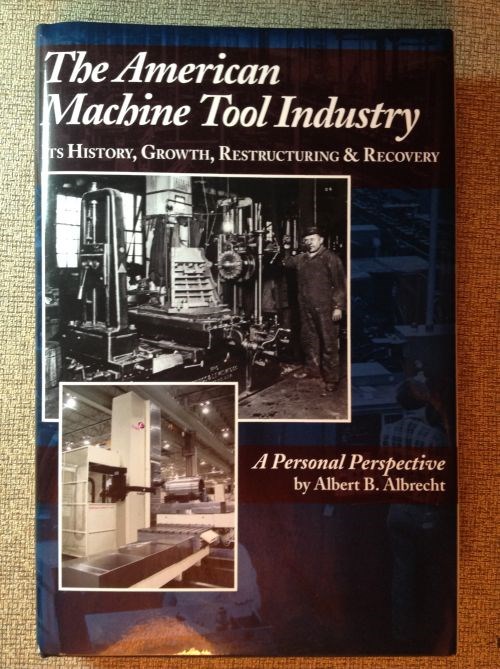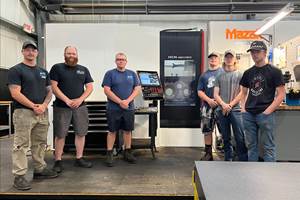A New Take on Machine Tool History
An enlarged, updated and revised edition of “The American Machine Tool Industry” by Albert B. Albrecht is now available. This new book includes a discussion and analysis of the industry's resurgence since the start of the new century, but retains the author’s personal but perceptive interpretation of its history when U.S. builders were the dominant force in the global machine tool industry.

Albert B. Albrecht has a new book out and it is a good one. It is an enlarged, updated and revised edition of his book “The American Machine Tool Industry,” first published in 2009. The original title has been retained, but the subtitle has been changed from “Its History, Growth and Decline” to “Its History, Growth, and Restructuring & Recovery.” Mr. Albrecht’s discussion and analysis of the industry’s current resurgence are chiefly what makes this new edition different and worth buying to replace the earlier editions. You’ll find the bulk of this enhanced content in the last 60 pages or so.
Here, Mr. Albrecht focuses on the positive changes and developments in the industry that have occurred in the first part of the 21st century. The main message is that machine tool building in the United States is alive, well and gaining strength (although serious challenges and obstacles persist). The author is apparently reconciled to the fact that many of the machine tool factories that are growing and prospering in this country belong to builders based overseas. It is also apparent that he is quite gratified that the machine tool factories belonging to U.S.-based builders, such as Haas Automation, are as advanced and productive as any in the world.
Of the seven chapters in the new section, the two most interesting are 20: Machine Tool Builders of the 21st Century and 21: Machine Tools of Today & Tomorrow. The former includes short profiles of builders whose outlook and capability exemplify the state of U.S. machine tool building. Mr. Albrecht pinpoints what he says are the keys to their success: a clear-cut corporate purpose, a strong sense of identity and values beyond just making a profit. The following chapter presents a sample of advanced machine tools that characterizes the current level of metalworking and metalcutting technology.
The next two chapters reiterate the commonly held notions that the biggest hindrances to the American machine tool industry, and to manufacturing in general, are unenlightened public policy (mainly misguided tax laws) and the shortage of skilled workers. The fixes that he endorses for this shortage are projecting a “cooler” image for manufacturing and reviving traditional apprenticeships.
My positive comments in the review of the first edition of Mr. Albrecht’s book still apply to the preceding sections of the latest version. His history of the industry comes to life in his personal accounts of what he observed and learned as an engineer, then a manager, during the “Golden Years” of U.S. machine tool building when it was the dominant force in the global industry. This period, he says, lasted from 1948 to 1998. The color illustrations added throughout the book are especially complementary to the vivid descriptions in these historical chapters.
I found this latest edition to be better organized and easier to follow than prior editions, yet it retains the intensity and earnestness of the original work. As in the prior editions, however, you will have to overlook some pesky lapses in proofreading and copyediting.
Anyone interested in machine tools and the history of manufacturing technology as told from an insider’s perspective should own this book. I wish a copy could be given to every young person entering an educational program related to machining, manufacturing or engineering. I would tell these recipients that reading it cover to cover right away may not be the best way to absorb the value of this book. Instead, I would recommend that they page through it every once and a while as they learn more about technology and develop their manufacturing skills. Each time they did this, they would be reminded of the tradition and promise that still inspire careers in manufacturing. And each time, they would find facts, comments and lively stories that impart a greater significance than they were able to perceive the time before.
In my 2010 review, I said Mr. Albrecht’s original book represented a fitting “closing act” in his long career. I’m glad I was wrong about that. I hope further encores in perceptive writing by Mr. Albrecht still lie ahead.
To obtain a copy, write to Albert B. Albrecht, 3290 Toddsbury Lane, Richmond, Indiana 47374. Thanks to support from AMT-The Association For Manufacturing Technology, the cover price of this new edition has been reduced to $32. Shipping by priority mail is $7.50. You can also reach the author at albertalbrecht@frontier.com.
Related Content
Top Shop Builds Upon Employee Ownership for Future Success
In its quest to become the Fox Valley’s best-in-class employer, A to Z Machine has adopted an ESOP, expanded benefits and invested in apprenticeships.
Read MoreCan Connecting ERP to Machine Tool Monitoring Address the Workforce Challenge?
It can if RFID tags are added. Here is how this startup sees a local Internet of Things aiding CNC machine shops.
Read MoreWill the “Great Resignation” Become an Opportunity for Manufacturers? Get Ready for the Returning 3 Million
The Great Resignation will become a Great Reapplication when employees currently able to stay out of the workforce return to it looking for something better. Machining employers that are already evaluating candidates for fit, without demanding specific skills coming in, might be positioned well to draw upon this wave.
Read MoreIf the Federal Government Is to Solve the Manufacturing Labor Shortage, it Needs to Start Here
Student-run businesses focused on technical training for the trades are taking root across the U.S. Can we — should we — leverage their regional successes into a nationwide platform?
Read MoreRead Next
3 Mistakes That Cause CNC Programs to Fail
Despite enhancements to manufacturing technology, there are still issues today that can cause programs to fail. These failures can cause lost time, scrapped parts, damaged machines and even injured operators.
Read MoreThe Cut Scene: The Finer Details of Large-Format Machining
Small details and features can have an outsized impact on large parts, such as Barbco’s collapsible utility drill head.
Read More























